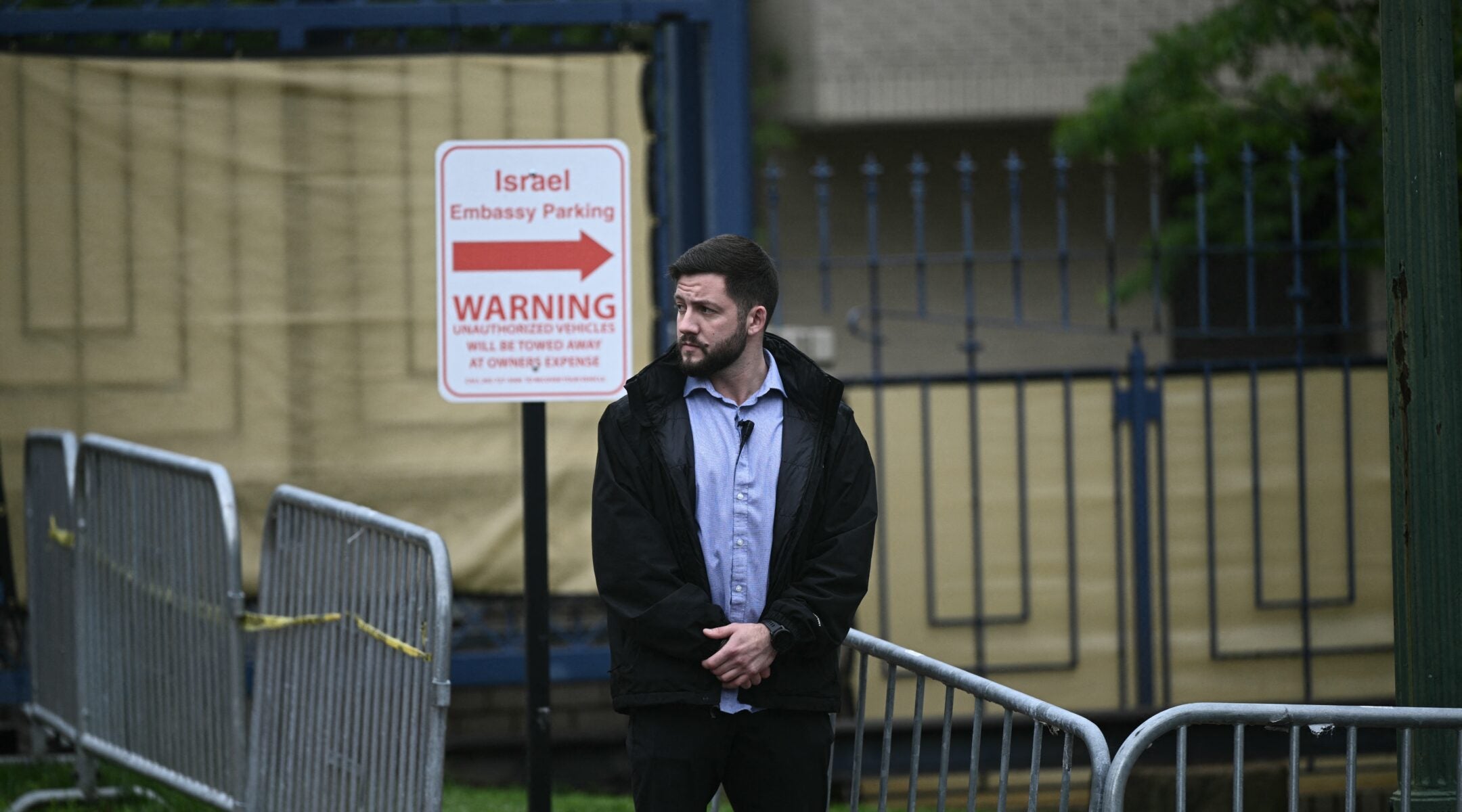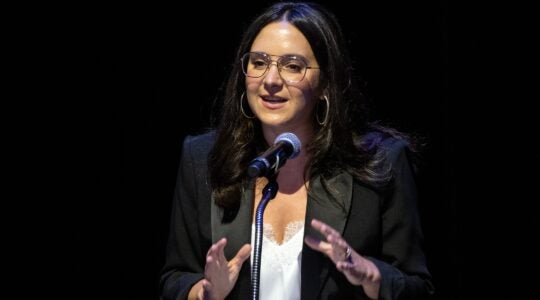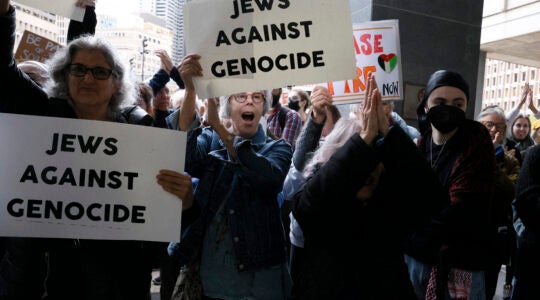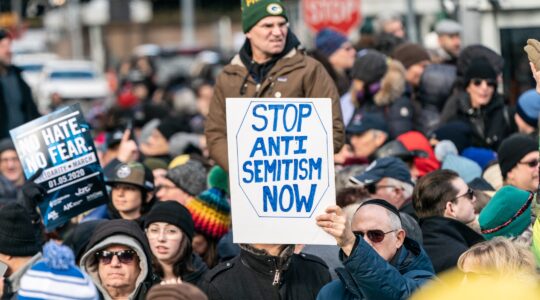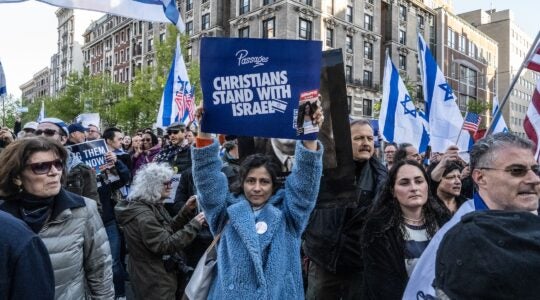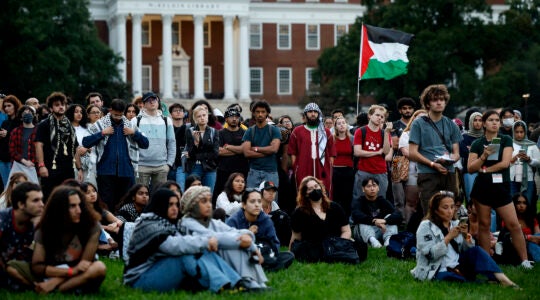On Wednesday night, three armed security officers stood guard as the Jewish Community Relations Council of Greater Washington held its annual meeting in the nation’s capital. On the agenda: discussions about the various ways antisemitic rhetoric can lead to violence.
Hours later, JCRC CEO Ron Halber said, he found out about the deadly shooting of two Israeli embassy staff at the Capital Jewish Museum. It was a nightmare come to life.
“It’s just godawful. There’s no other way to describe it. It was a horrific, antisemitic, anti-Israel, violent attack,” Halber told the Jewish Telegraphic Agency Thursday. “For years I’ve said in Washington, we’re lucky we’ve never had anything” of this magnitude attacking the Jewish community. “That record came to an end last night.”
In the attack’s aftermath, Jewish community professionals including Halber are refocusing, again, on how to protect their institutions from threats. The shooting has also raised urgent questions: What went wrong? And what needs to change?
“Why they failed tonight we obviously have to figure out,” Eric Fingerhut, CEO of the Jewish Federations of North America, said in an interview with JTA hours after the shooting, regarding security.
He added later, “The risks have continued to rise as antisemitism has risen and as anti-Israel behavior in America has risen and our security teams have worked so hard to keep up with that. They obviously didn’t succeed tonight but we will not stop until we’ve ensured the security of our community.”
The timeline of the attack is relatively clear and, to security analysts, troubling: According to reports, the attacker shot his victims, the couple Yaron Lischinsky and Sarah Milgrim, on the street outside the museum as the event, organized by the American Jewish Committee, was winding down.
He then walked inside the museum, where an eyewitness said organizers offered him water and he remained for around 10 minutes until police arrived and he confessed to the shooting. Both elements of the incident — that the attacker was able to reach his victims outside the event and then proceed inside for an extended period of time — indicate missteps, according to security professionals.
“What concerned me as a seasoned law enforcement official is in all the work and the efforts that we put into training civilians, his behavior was almost literally screaming that there’s an issue here,” said Paul Goldenberg, the former head of the Secure Community Network, which coordinates security for Jewish institutions nationwide. Goldenberg said that in a widely circulated video of the suspect entering the building, he appeared nervous and disheveled, with jerky movements.
Goldenberg says in the future, rank-and-file attendees need to be aware of those signs — and act on them by alerting someone.
“The second he walked in after the shooting there should have been a plan,” added Goldenberg, who is now the chief policy adviser and head of global policing at Rutgers University’s Miller Center on Policing. “If we know that he just shot individuals outside, whatever security was in place, he never should have made it inside that building.”
Neither the AJC nor the museum immediately responded to JTA queries about who was responsible for security on Wednesday night. But by Thursday afternoon, five of the leading Jewish groups that focus on security put out a series of security recommendations for future events.
The recommendations focus principally on expanding the security perimeter of events; withholding the details of events and vetting attendees; and coordinating with law enforcement or hiring security guards.
The AJC had done at least some of that: The invitation said the location would be “shared upon registration.”
“The Jewish community is already among the most hardened targets in the country,” Oren Segal, who oversees the ADL’s Center on Extremism, told JTA prior to the recommendations being publicized. “Bulletproof glass and metal detectors is the norm. And the question is, how broad does the perimeter need to be for the Jews to feel secure?”
Leading up to the event, the museum was broadly conscious of threats. The day before the shooting, it had announced a new security grant from the local D.C. government — one that Halber said the JCRC had helped arrange — in connection to a new exhibit on LGBTQ Jews.
The $30,000 grant was meant to help the museum cover the costs of security guards both at the front desk and roaming around the museum “to make sure that everybody is safe and that we are prepared in the event of an emergency,” executive director Beatrice Gurwitz told local news at the time. She added that the grant “also helps our staff prepare.”
After the shooting, Gurwitz and the museum’s board said in a statement they were “heartbroken by the murders,” vowing to reopen in the coming days “with all necessary security in place.”
In addition to the museum grant, Halber has also helped arrange state and local Jewish security grants in Maryland and Virginia. He is now urging increased funding of security at Jewish institutions — funding that has already seen massive boosts in recent years following 9/11, the mass shooting at a Pittsburgh synagogue and other antisemitic attacks — and pushing the federal government to free up “billions” in more security funding for such centers.
That money, he believes, should not go toward major capital improvements like state-of-the-art monitoring systems; instead, he believes Jewish institutions are most in need of funding everyday operating costs to pay security guards and other basic needs.
Halber added that he did not blame the AJC, whose senior staff he knows personally, for any lapses. He also acknowledged that it’s impossible to fully secure oneself from all threats, while noting that the fact the victims were shot outside the venue suggested one proper course of action could be to “extend the perimeter around our institutions.”
“Resources are finite,” Halber said. “I know they did everything possible. There’s no blame to AJC on this. But how far can you extend the perimeter? One block, two blocks?”
Other Jewish community leaders with security expertise told JTA that, while physical security measures remain crucial, they should not be expected to stop every attack.
“We have to know that these things are possible — not probable, but possible,” Rabbi Charlie Cytron-Walker, who escaped from a hostage-taker at his former synagogue in Colleyville, Texas, in 2022, told JTA on Thursday. Cytron-Walker has credited his own security training with saving his life and those of his congregants.
Now the rabbi at Temple Emanuel in Winston-Salem, North Carolina, Cytron-Walker said Jews should have the expectation that their communal leaders “are doing everything they can to make sure that people can not only feel a sense of safety, but to actually have real security protocols in place that enhance our safety.”
Yet, he said, “We also have to acknowledge and understand that in any situation, there’s no way to be 110% secure.”
Cytron-Walker also famously gave his attacker tea when he entered the synagogue — something the rabbi said he’d do again as an expression of the Jewish value of welcoming guests. Asked about the 10 minutes Wednesday’s attacker spent in the museum after killing two people, Cytron-Walker said he didn’t “see a specific parallel” between the two scenarios.
“This individual, it appears, wanted to kill Jews,” he said. “The gunman in my situation wanted to get a convicted terrorist springed. I am grateful in our situation that he didn’t just walk into the synagogue and want to kill Jews. It gave us an opportunity to escape 11 hours later.”
Instead of focusing on physical security, some Jewish leaders said, there should be greater attention paid to what they believe is the real security threat: virulent anti-Israel sentiment, online and in protest networks, that has risen in the months since Oct. 7, 2023, and the Israel-Hamas war in Gaza.
“I can’t help but think that the persistent demonization of Israelis and Jews, along with the constant glorification of terrorist groups at various events and protests since Oct. 7, created an environment that made this tragedy more likely,” Segal said. “These rhetoric and narratives have consequences.”
The ADL conducts extensive threat monitoring, but Segal said they had not been aware of the shooter’s identity prior to the attack. “He was not top-10-to-watch for us,” he said. “We can’t bat a thousand.”
But, he said, the ADL has been tracking groups “this person is associated with,” including the ANSWER Coalition and the Party for Socialism and Liberation. In a statement on X, the latter group said they had “no contact” with the shooter since 2017 and added, “We have nothing to do with this shooting and do not support it.”
Goldenberg also acknowledged that “I don’t think anyone in this business has ever seen a hotter environment than what we see right now.” And in that environment, he said, everyone, even regular attendees at an event, needs to stay on alert.
“Every single individual has a place when it comes to their own personal security and the security of people around them,” he said. “I’m not saying these people should be cops or behave like cops or counterterrorism specialists.”
But he added, “What people cannot do in this environment is hesitate for a second if they see anything that is suspicious.”
With additional reporting by Ben Sales.
JTA has documented Jewish history in real-time for over a century. Keep our journalism strong by joining us in supporting independent, award-winning reporting.
